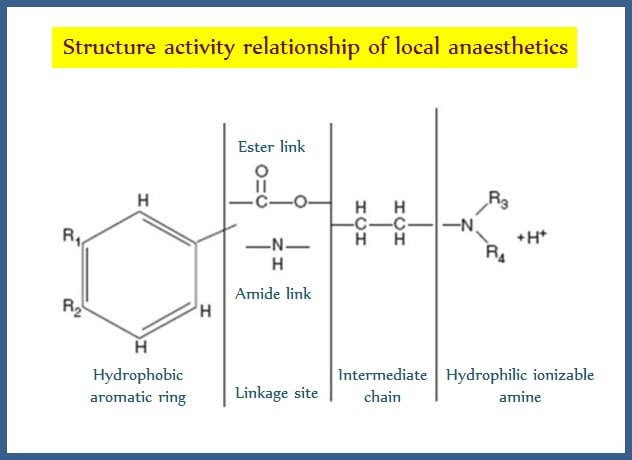TABLE OF CONTENTS
Local anesthetics in animals
Local anesthetics in animals are agents applied locally to skin/mucosa for reversible blockade of the nerve impulses. they effectively block the somatic sensory, somatic motor, and ANS.
Using of local anesthetics in animals make No need for general anesthesia (GA) and surgery performed in standing posture with or without sedation.
These avoids prolonged recumbency and no specialized equipment or technique required and easy to practice
Ideal properties of a Local Anaesthetics
- Should produce reversible paralysis
- Should be non addictive
- Should be readily soluble and stable in water
- Non irritant to the skin
- Minimal toxicity
- Compatible with epinephrine
- Slowly absorbed to have long duration of action
- Inexpensive
- Not induce hyperesthesia
Comparison of General and Local anaesthetics
| General anesthetic | Local anesthetic |
| Site of action CNS | Peripheral nerves |
| Whole body is involved | Restricted area is involved |
| Consciousness is lost | Consciousness is retained |
| Care of vital functions essential | Care of vital functions not needed usually |
| Risky in poor health | Safer even in poor health |
| Physiological trespass is high | Physiological trespass is low |
| Preferred for major surgeries | Not preferred (only minor surgeries can be performed) |
Chemistry of Local Anesthetics
Local anaesthetics are divided chemically into two groups-
- Lengthening of intermediate chain or addition of Carbon atoms in the amine or aromatic increase in potency
- Addition of butyl group to the amine or aromatic end → lipid solubility, protein binding → increased potency and long action

Features of Amide LAs
- More intense and longer lasting anaesthesia
- Bind to plasma protein ( α1 acid glycoprotein)
- Not hydrolyzed by plasma esterases
- Rarely cause hypersensitivity
- Ester type LAs – cocaine, procaine, chloroprocaine, tetracaine, benzocaine
- Amide type LAs – lidocaine (lignocaine), bupivacaine, dibucaine, prilocaine
Mechanism of action of Local anesthetics
Local anesthetics block nerve conduction by decreasing entry of Na+ ions during action potential. As the concentration of LA is increased – rate and rise of spike potential decreases leading to slowing down of conduction
Local anesthetic enters the inside of the cell in unionized form and gets ionized (cationic). Binds to the receptor on the Na+ channel and stabilizes channel in the inactivated state. Blockade efficient at a rapidly stimulated nerve rather than a resting nerve, Higher frequency of stimulation greater is the blockade.
Small and nonmyelinated fibres more sensitive than myelinated fibres but Autonomic nerves more susceptible than somatic fibres.
Order of blockade is: pain – temperature– touch – deep pressure sense
Small sensory fibers more vulnerable than motor fibers. addition of epinephrine prolongs action by vasoconstriction and Reduces systemic toxicity of local anesthetic, Increases local pain, edema and painful injection.
Pharmacokinetics and adverse effects
- pKa between 8 and 9-mostly ionised at body pH.
- Given at a local site. Absorption and distribution not desired. If absorbed and distributed, may cause CNS and cardiac toxicity
- Vasoconstrictors ↓ absorption
- Ester type broken down by esterases while amide type – remain long acting
- Amide type – hydrolysed by Microsomal enzymes
- Metabolites excreted in urine
- Adverse effects –
- CNS – Initial stimulation → tremor, restlessness, convulsions and death
- Higher doses – depression
- Low non-seizure dose used for euphoria in man and to enhance performance in horses
- CVS – decreasemyocardial contractility, rate and force of conduction – dilatation of the arterioles
- Renal and hepatic blood flow – decrease the blood fow to liver and kidney solower the metabolism and excretion
Types of local anesthesia
- Topical as solutions, gels, ointments, powders, to the skin or mucous memberane of the eye, ear, nose, mouth, pharynx, urethra, uterus or teat canal – lignocaine, tetracaine or amethocaine
- Infiltration – highly diluted local anesthetic solution in small quantities is injected subcutaneously in multiple places in the area of surgery. Lignocaine, procaine, bupivacaine, or mepivacaine
- Peripheral Nerve Block – Injecting the local anesthetic in the vicinity of the peripheral nerve or plexus. esp. for limbs. Eg. Plantar or median nerve block in cattle lignocaine, procaine, bupivacaine, or mepivacaine
- Paravertebral Anesthesia – drugs applied to the spinal nerves as they emerge from the intervertebral foramen – anaesthetizes a large area
- Used for caesarean or rumenotomy in cattle ( done in a standing cattle)
- Epidural Block – injecting into the epidural space at the lumbosacral junction. For any procedure to be conducted on the pelvic region and beyond. Other drugs like opioids, alpha 2 agonists, NSAIDs, corticosteroids etc. can be used to increase efficacy
- Spinal block – Injection into CSF – not normally practiced
- Regional anesthesia/retrograde anesthesia – Injected intravenously into an area desired for anesthesia and a tourniquet is applied above the site of injection. After the procedure, the tourniquet is loosened and the drug effect wanes due to dilution – eg: lignocaine, bupivacaine, or mepivacaine can be used.
Local Anesthetic drugs used in animals
Procaine
Procaine is introduced in 1905. this hydrolyzed by choline esterase to alcohol and PABA. It is a Short acting and rapidly metabolized in plasma. Also has antiarrhythmic effect but Not to be used when sulphonamides are given.
Tetracaine
Tetracaine is a ester type local anesthetics. it is used for topical anesthesia.
Lignocaine
Lignocaine (lidocaine) is a amide type local anesthetic which widely used in human and veterinary medicine. It is Resistant to choline esterase, may produce ventricular fibrillation or cardiac arrest in large doses. lidocaine has no tissue irritation, rapid onset of action, better diffusion and longer duration of action. Also used as antiarrhythmic agent.
Mepivacaine
Mepivacaine is similar to lignocaine but longer acting. Not effective topically.
Bupivacaine
Bupivacaine is a long acting and more potent (4 times than lignocaine). it is used for regional blocks and epidural blocks.
Ropivacaine
Ropivacaine is a amide type, long acting, less CVS and CNS toxicity than bupivacaine